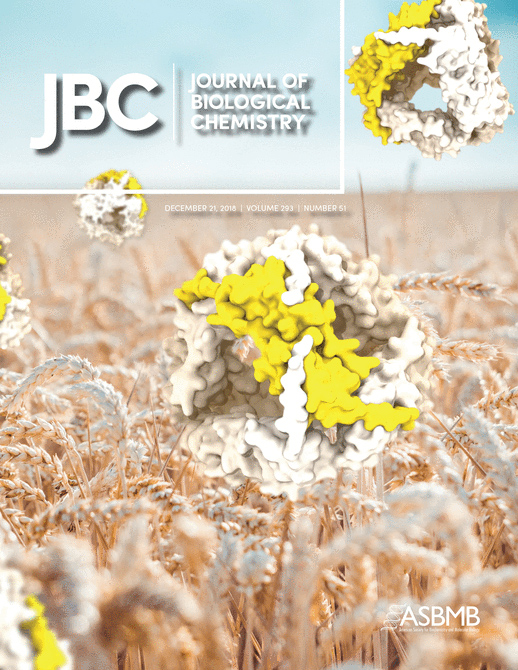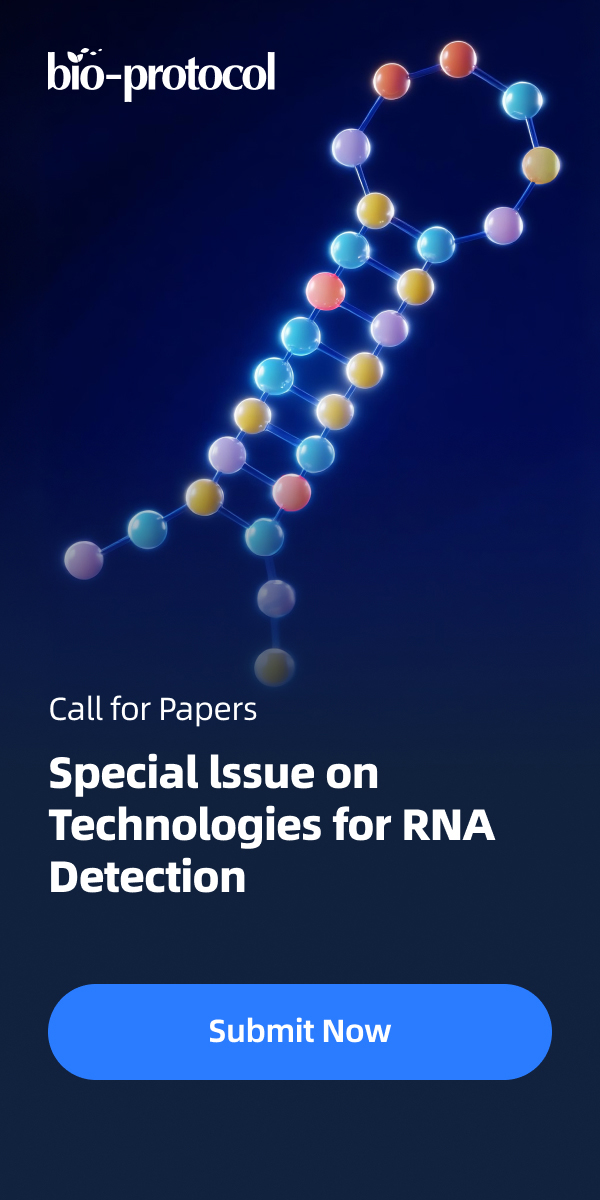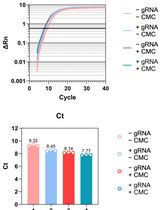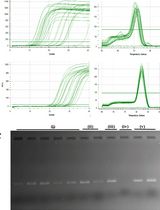- EN - English
- CN - 中文
Improved Mammalian Mitochondrial RNA Isolation
一种改进的哺乳动物线粒体RNA分离方法
发布: 2019年06月05日第9卷第11期 DOI: 10.21769/BioProtoc.3247 浏览次数: 8231
评审: Aswad KhadilkarAlvaro Eduardo GalvisAnonymous reviewer(s)
Abstract
Mitochondria have two sets of RNAs. One is encoded in mitochondrial genome, and the other that consists of imported RNAs within mitochondria and cytosolic RNAs associated with mitochondrial outer membrane is encoded in the nucleus. These mitochondrial RNAs play important roles in mitochondrion biosynthesis and signaling in and out of mitochondria. Isolation and analysis of mitochondrial RNAs can provide useful information on understanding the mitochondrial regulation of cellular processes. However, several ribonuclease activities have been found in mitochondria, which will degrade mitochondrial RNAs during the isolation process if they are not properly inactivated. Here, we describe an improved method to inactivate the ribonuclease activities prior to RNA extraction, and thus provide a reliable protocol to isolate mammalian mitochondrial RNAs for quantitative RT-PCR and other assays.
Keywords: Mitochondrial RNA (线粒体RNA)Background
Mitochondrial RNAs are more diverse than originally thought. Firstly, each strand of mitochondrial DNA is transcribed as a long polycistronic transcript and processed to mature mRNAs, rRNAs and tRNAs (Hällberg and Larsson, 2014). Secondly, some nucleus-encoded noncoding RNAs are imported into mitochondria (Entelis et al., 2002; Wang et al., 2010; Mercer et al., 2011; Zhang et al., 2014; Cheng et al., 2018). In addition, cytosolic ribosomes and some mRNAs are found to be associated with mitochondrial outer membrane (Kellems and Butow, 1972; Williams et al., 2014). Analysis of mitochondrion-related RNAs can provide important information on understanding the mitochondrial biosynthesis and mitochondrial regulation of cellular processes, such as protein translation (Huang et al., 2018) and aging (Zheng et al., 2019). However, isolation of mitochondrial RNAs can be problematic since there are several strong ribonucleases within mitochondria (Rorbach et al., 2011; Bruni et al., 2013; Levy et al., 2016; Liu et al., 2017). Some of these ribonucleases remain highly active even under harsh conditions, such as proteinase-K treatment (Liu et al., 2017). To avoid partial degradation of mitochondrial RNAs after lysis of mitochondria, a reliable method to inactivate these ribonucleases during RNA isolation is needed. Most current mitochondrial RNAs isolation protocols, however, do not mention the potential consequences of incomplete RNase inactivation. Chloroform (Geiger and Dalgaard, 2018) or commercial kits (Sripada et al., 2012) are routinely used, but neither could completely inactivate the mitochondrial ribonucleases. In one protocol (Mager-Heckel et al., 2007), sodium dodecyl sulfate (SDS) and high temperature (100 °C) are used, but these conditions have a negative effect on RNA stability (Sidova et al., 2015). Here, we describe an improved method to inactivate the ribonuclease activities prior to RNA extraction. In this method, SDS lysis coupled with a milder temperature (70 °C) incubation denatures most proteins without causing RNA instability and the subsequent proteinase K digestion degrade nearly all proteins, providing a reliable protocol to isolate mammalian mitochondrial RNA for quantitative RT-PCR and other assays.
Materials and Reagents
- 1.5 ml microcentrifuge tubes (Quality Scientific Plastics, catalog number: 509-GRD-Q)
- 0.22 μm filter (Merk, Millex-GP PES, catalog number: SLGP033RB)
- Nuclease-free pipette tips (Quality Scientific Plastics, catalog numbers: T104RLS-Q, T090RLS-Q and T112NXLRLS-Q)
- Tris (AMRESCO, catalog number: 0497-5KG)
- Sodium dodecyl sulfate (SDS) (AMRESCO, catalog number: 0227-1KG)
- EDTA, disodium salt, dihydrate (Na2EDTA·2H2O) (AMRESCO, catalog number: 0105-1KG)
- Proteinase K (AMRESCO, catalog number: 0706-100MG)
- 6x DNA Loading Dye (Thermo Fisher Scientific, catalog number: R0611)
- Agarose (BIOWEST, Regular Agarose G-10, catalog number: 111860)
- Nuclease-free water (AMRESCO, catalog number: E476-1L)
- Double distilled water (ddH2O)
- DNase I, RNase-free, supplied with 10x Reaction buffer with MgCl2 (Thermo Fisher Scientific, catalog number: EN0521)
- TRIzol (Life Technologies, catalog number: 15596018)
- 1-Bromo-3-chloropropane (Sigma-Aldrich, catalog number: B9673)
- Isopropanol (AMRESCO, catalog number: 0918-1L)
- Ethanol (Sigma-Aldrich, catalog number: 459836-2L)
- HCl (Beijing Chemical Works, Analytic Reagent grade)
- NaOH (sodium hydroxide pellets) (Shanghai Sangon Biotech, catalog number: A100173)
- GeneRuler 1 kb DNA Ladder (Thermo Fisher Scientific, catalog number: SM0311)
- HEPES free acid (AMRESCO, catalog number: 0511-1KG)
- Mannitol (AMRESCO, catalog number: 0122-500G)
- Sucrose (AMRESCO, catalog number: 0335-500G)
- MitoPrep buffer (see Recipes)
- 10% (w/v) SDS (see Recipes)
- 1 M Tris-HCl (pH 7.4) (see Recipes)
- 0.5 M EDTA (pH 8.0) (see Recipes)
- Proteinase K (1 mg/ml) (see Recipes)
- Lysis buffer (see Recipes)
- 1x DNase buffer (see Recipes)
- 75% ethanol (v/v) (see Recipes)
Equipment
- Pipettes (RAININ, Pipet-Lite XLS)
- Two heat blocks (Hangzhou Allsheng Instruments, Product Name: dry bath incubator, catalog number: MK200-2)
- NanoDrop instrument (Thermo Fisher Scientific, NanoDrop 2000c Spectrophotometer)
- Power supply (Tanon, catalog number: EPS 300)
- Gel imaging system (Tanon, catalog number: 1600)
- Centrifuges (Thermo Fisher Scientific, models: Sorvall Legend Micro 21 and Micro 21R)
- pH meter (Sartorius, catalog number: PB-10)
- -80 °C freezer (Thermo Fisher Scientific)
- Magnetic stir bars and magnetic stirrer
- Fume hood
- Laminar flow cabinet
- Incubator
- 4 °C refrigerator
- -20 °C freezer
Procedure
文章信息
版权信息
© 2019 The Authors; exclusive licensee Bio-protocol LLC.
如何引用
Readers should cite both the Bio-protocol article and the original research article where this protocol was used:
- Huang, J. and Wang, G. (2019). Improved Mammalian Mitochondrial RNA Isolation. Bio-protocol 9(11): e3247. DOI: 10.21769/BioProtoc.3247.
- Huang, J., Liu, P. and Wang, G. (2018). Regulation of mitochondrion-associated cytosolic ribosomes by mammalian mitochondrial ribonuclease T2 (RNASET2). J Biol Chem 293(51): 19633-19644.
分类
分子生物学 > RNA > RNA 提取
细胞生物学 > 细胞器分离 > 线粒体
您对这篇实验方法有问题吗?
在此处发布您的问题,我们将邀请本文作者来回答。同时,我们会将您的问题发布到Bio-protocol Exchange,以便寻求社区成员的帮助。
Share
Bluesky
X
Copy link














